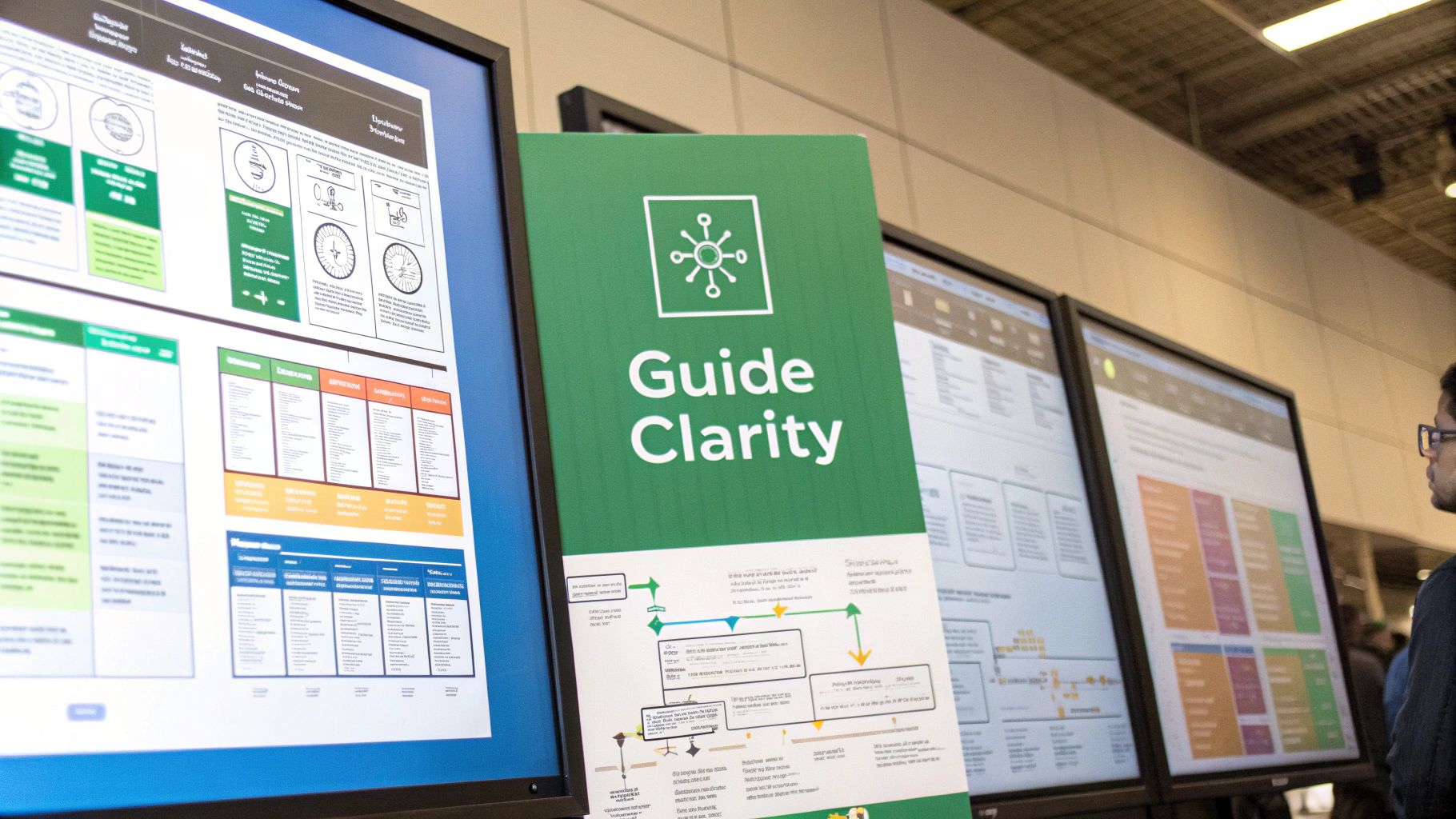Master technical documentation with proven strategies that drive team efficiency and user success. Learn from industry experts how to create, manage, and scale documentation that delivers measurable impact.

When you hear “technical documentation,” what comes to mind? If you picture thick manuals collecting dust or bewildering diagrams that only experts can understand, it’s time for an update. Today’s technical documentation has moved far beyond these outdated stereotypes into something much more practical and user-focused. Companies now see documentation as a key asset that directly impacts their success, not just an obligation to check off a list.
Technical documentation as we know it began taking shape in the late 1940s alongside the rise of computers. The first real technical document was created in 1949 - a user manual for the BINAC computer. This marked the beginning of technical writing as its own profession. The 1980s brought major changes when desktop publishing software made it possible to create better-looking, easier-to-read manuals. In 1986, SGML introduced structured authoring, which helped writers organize and manage documents more effectively.
The field continued to develop through the 1990s and early 2000s. ISO 9000 certifications pushed companies to standardize their documentation processes, while XML became the go-to format for technical content. The Sarbanes-Oxley Act of 2002 added another layer of importance by requiring detailed technical documentation for corporate compliance.
Today’s technical documentation focuses on making information accessible and useful. Here’s what that looks like in practice:
AI is bringing new capabilities to technical documentation. It can help with repetitive tasks, speed up content creation, and even power chatbots that answer user questions directly from the documentation. But AI isn’t replacing human technical writers - instead, it’s giving them better tools to work with. Writers still need to ensure the content is accurate, nuanced, and aligned with business goals. They’re becoming more like content strategists, using AI to improve their work rather than being replaced by it.
Documentation is a critical bridge between technical products and their users. While AI tools can help create documentation faster, the real challenge lies in making it engaging and useful for readers. Success comes from understanding how people learn and interact with technical content, then applying proven principles to create documentation they’ll actually want to read.
Great documentation starts with knowing your readers inside and out. What background knowledge do they bring? What are they trying to accomplish? What challenges do they face? The answers shape every aspect of your documentation approach. For example, when writing for seasoned developers, you can use technical terminology and focus on advanced concepts. But documentation for general users needs clear explanations and step-by-step guidance without assuming prior knowledge.
Good organization is just as important as good writing. The most successful documentation uses research-backed techniques to help readers learn and retain information:
Modern documentation must work for everyone. Key accessibility considerations include:

Creating great technical documentation requires the right tools to support your team’s workflow. With so many options available, selecting documentation tools can feel daunting at first. However, by focusing on your specific needs and must-have features, you can find tools that will help your team work efficiently and produce high-quality documentation. Just like a carpenter needs reliable tools to build effectively, documentation teams need proper tools to create and maintain their content.
Start by identifying what matters most for your documentation process. Does your team need strong version control capabilities? Is real-time collaboration essential? How will the tool fit into your existing development workflow? Your answers will help narrow down the options. For instance, small teams may do well with simple cloud tools, while larger organizations often need advanced features like content reuse and automated publishing.
Here are the main factors to evaluate:
Several strong documentation platforms exist today, each with their own advantages. Compare these key features against your requirements to find the best fit:
For example, Platform A works well for open-source projects needing Git integration at no cost. Platform C better serves teams focused on easy collaboration, even though it requires paid licenses.
Once you select a tool, successful implementation takes careful planning. Consider team training needs, how to move existing content, and connections with your current tools. Start with a small pilot program to work out any issues before rolling out to your full team.
The tool should work smoothly with your code repository and issue tracking system to reduce context switching. While setting up these integrations takes effort upfront, it pays off in improved efficiency. Make sure your vendor provides clear integration guides and support. When done right, good tool implementation leads to better documentation quality, happier teams, and improved experiences for your end users.
Good technical documentation does much more than simply explain how products work - it can significantly improve a company’s bottom line. When approached strategically, documentation becomes an invaluable business asset that drives measurable results across multiple areas of the organization.
Clear documentation directly reduces pressure on support teams by helping users find answers independently. When customers can quickly solve common issues through well-organized documentation, they make fewer support requests. This means support staff can focus on handling complex cases that truly need their expertise.
A good example is having detailed FAQ pages that address frequent questions. Rather than repeatedly answering the same basic inquiries, support agents can dedicate their time to resolving challenging problems. This both cuts costs and leads to happier customers who feel empowered to help themselves.
Quality documentation helps new users get started quickly and effectively with your product. By providing clear tutorials, guides and examples, you give users the confidence to begin using key features right away. This is especially important for complex software products where users need guidance to understand core functionality.
The faster users can grasp how your product works, the more likely they are to stick with it long-term. Simple, accessible documentation removes friction from the learning process and encourages users to deeply integrate the product into their regular workflows.
While measuring documentation’s business impact can be tricky, it’s essential for getting buy-in from stakeholders. Teams can track concrete metrics like:
Documentation works best when tightly integrated with broader company objectives. This requires documentation teams to collaborate closely with product, marketing, and support departments. Understanding key business priorities helps documentation teams create content that actively supports those goals.
For example, if expanding into new markets is a priority, documentation should specifically address the needs of those target customers. This strategic approach ensures documentation actively contributes to business success rather than just meeting basic technical requirements. Working together across teams also keeps documentation aligned with the product’s overall messaging and branding.

Good technical documentation requires more than writing skills and tools - it needs a systematic approach built on proven practices. Just as developers follow coding standards and testing protocols, documentation teams need clear processes to maintain quality and consistency over time. When done right, these practices help documentation become a true asset that serves both users and the organization.
A style guide sets the foundation for professional documentation by defining standards for grammar, terminology, and formatting. For example, being consistent about whether you use “click” or “select” for button actions makes a real difference in readability. These seemingly minor choices add up to create documentation that feels polished and trustworthy. The guide should also establish a clear voice that reflects your brand while keeping the focus on helping users accomplish their goals.
Clear review processes catch errors before they reach users. Start by defining who handles different types of reviews - technical accuracy, editorial quality, and final sign-off. This clarity prevents confusion and ensures thorough review coverage. Consider using a platform like Confluence to manage collaborative editing and feedback. With the right workflow, reviewers can track changes and communicate effectively while keeping the documentation process moving forward.
Documentation can fall behind product changes, creating confusion for users and extra work for support teams. The key is staying proactive - treat documentation updates as part of feature development, not an afterthought. Regular reviews help spot outdated content before it causes problems. When teams prioritize keeping documentation current alongside code changes, they prevent small gaps from growing into major issues that take significant effort to fix.
Users provide essential insights about what works and what needs improvement in documentation. Adding feedback options like quick surveys or comment sections creates direct communication channels with readers. Teams can then identify common pain points and make targeted improvements. For example, if multiple users struggle with a particular feature explanation, that’s a clear signal to revise that section or add visual aids like screenshots or video walkthroughs.
As products grow more complex, keeping documentation quality high becomes challenging. Tools like automated grammar and style checkers help maintain consistency across large content sets. Version control systems make it easier to track changes and revert if needed. Setting clear metrics around user satisfaction and support ticket volume helps teams measure their impact and focus improvements where they matter most. This balanced approach of automation and human oversight helps documentation scale effectively while staying useful and accurate.

Technical documentation constantly changes to keep pace with new technologies and user needs. Teams need to stay informed about emerging approaches to create documentation that remains useful and relevant. Let’s explore the key developments shaping how technical content is created and consumed.
AI tools are bringing major changes to how technical documentation gets created. These tools can now handle repetitive tasks like generating basic content, translating materials, and checking facts. For instance, AI can automatically create documentation from code comments, giving developers more time to focus on their core work. AI also analyzes how people use documentation to create personalized experiences that match different learning needs. While AI helps with many tasks, human technical writers remain essential - they guide the AI tools and ensure the content is accurate, nuanced, and aligned with business goals.
Static PDFs and text articles no longer meet user expectations. People want documentation they can interact with and that fits their learning style. This includes adding videos, clickable diagrams, and hands-on simulations. Think about learning a new skill - reading about it helps, but seeing it demonstrated and trying it yourself leads to better understanding. By making documentation more engaging and interactive, teams can help users grasp complex topics faster and reduce support requests.
Making documentation work for everyone is now essential, not optional. Teams need to ensure their content is accessible to people with different abilities and needs. This means including alt text for images, keyboard navigation options, and compatibility with screen readers. Clear, straightforward language - a key part of accessible documentation - helps all users understand the content better, regardless of their background or abilities.
You don’t need to completely change your documentation process to embrace these new approaches. Start by finding specific areas where new tools and methods can make the biggest difference. If keeping content updated is challenging, AI automation might help. If users ask for more engaging materials, try adding videos or interactive elements. Taking small, focused steps lets you improve your documentation while maintaining quality and consistency.
Ready to improve your documentation process with AI tools? Check out DocuWriter.ai to see how our tools can help your team work more efficiently.